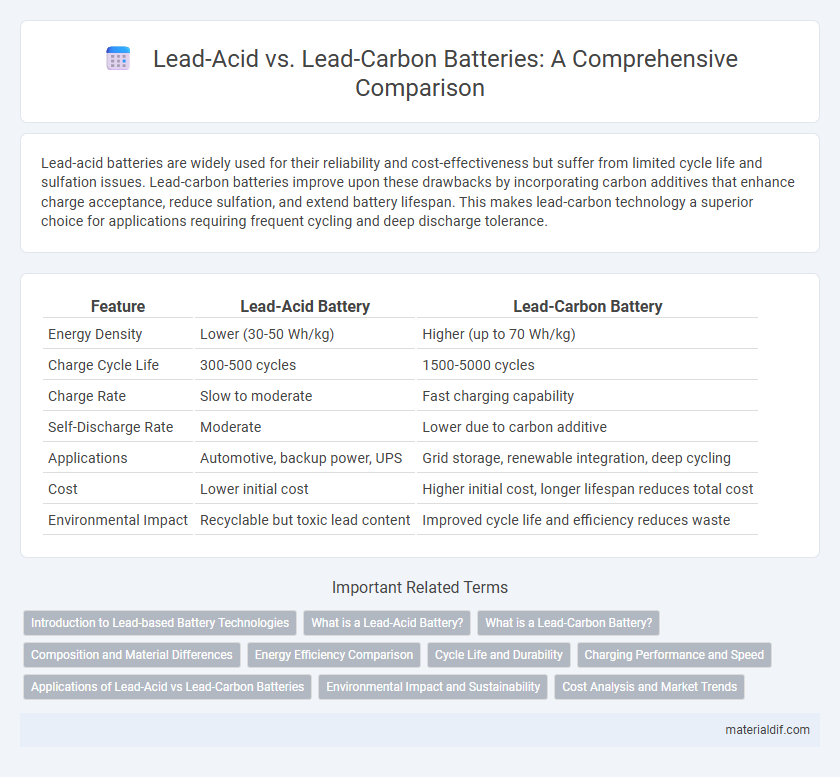Lead-acid batteries are widely used for their reliability and cost-effectiveness but suffer from limited cycle life and sulfation issues. Lead-carbon batteries improve upon these drawbacks by incorporating carbon additives that enhance charge acceptance, reduce sulfation, and extend battery lifespan. This makes lead-carbon technology a superior choice for applications requiring frequent cycling and deep discharge tolerance.
Table of Comparison
| Feature | Lead-Acid Battery | Lead-Carbon Battery |
|---|---|---|
| Energy Density | Lower (30-50 Wh/kg) | Higher (up to 70 Wh/kg) |
| Charge Cycle Life | 300-500 cycles | 1500-5000 cycles |
| Charge Rate | Slow to moderate | Fast charging capability |
| Self-Discharge Rate | Moderate | Lower due to carbon additive |
| Applications | Automotive, backup power, UPS | Grid storage, renewable integration, deep cycling |
| Cost | Lower initial cost | Higher initial cost, longer lifespan reduces total cost |
| Environmental Impact | Recyclable but toxic lead content | Improved cycle life and efficiency reduces waste |
Introduction to Lead-based Battery Technologies
Lead-acid batteries, widely used for over a century, rely on lead dioxide and sponge lead electrodes with sulfuric acid electrolyte, offering reliable energy storage for automotive and backup power applications. Lead-carbon batteries enhance traditional lead-acid technology by integrating carbon additives into the negative plate, improving charge acceptance, cycle life, and reducing sulfation. This advancement optimizes performance in partial state of charge conditions, making lead-carbon batteries well-suited for renewable energy storage and hybrid vehicle systems.
What is a Lead-Acid Battery?
A lead-acid battery is a rechargeable energy storage device that uses lead dioxide (PbO2) and sponge lead (Pb) plates submerged in sulfuric acid as the electrolyte to generate electrical energy through electrochemical reactions. Widely used in automotive starters, backup power supplies, and renewable energy systems, these batteries offer reliable power output and cost-effective performance. Compared to lead-carbon batteries, traditional lead-acid batteries may have shorter cycle life and slower charge acceptance due to sulfation issues on the lead plates.
What is a Lead-Carbon Battery?
A Lead-Carbon battery is an advanced type of lead-acid battery that incorporates carbon additives into the negative electrode to improve charge acceptance and cycle life. This technology enhances performance by reducing sulfation, a common cause of capacity loss in traditional lead-acid batteries, making it ideal for partial state of charge applications. Lead-Carbon batteries offer higher energy density, longer lifespan, and better efficiency compared to conventional lead-acid batteries.
Composition and Material Differences
Lead-acid batteries utilize lead dioxide as the positive plate and sponge lead as the negative plate, combined with sulfuric acid electrolyte, resulting in traditional energy storage systems. Lead-carbon batteries incorporate activated carbon into the negative electrode alongside lead, enhancing charge acceptance and reducing sulfation-related degradation. The addition of carbon materials significantly improves cycle life and efficiency compared to conventional lead-acid compositions.
Energy Efficiency Comparison
Lead-carbon batteries offer enhanced energy efficiency compared to traditional lead-acid batteries due to their improved charge acceptance and reduced sulfation rates. The incorporation of carbon additives in the negative plate enhances cycle life and reduces internal resistance, resulting in higher energy throughput. Lead-carbon technology supports faster charging and better performance in partial state of charge conditions, making it a more efficient choice for renewable energy storage and hybrid applications.
Cycle Life and Durability
Lead-carbon batteries exhibit significantly enhanced cycle life and durability compared to traditional lead-acid batteries due to the incorporation of carbon additives that reduce sulfation and improve charge acceptance. This modification extends cycle life up to three to four times longer, making lead-carbon batteries ideal for deep-cycle applications and frequent charge-discharge cycles. The improved durability also results in better performance under partial state-of-charge conditions, reducing capacity loss and maintenance requirements.
Charging Performance and Speed
Lead-carbon batteries outperform traditional lead-acid batteries in charging performance and speed due to their enhanced carbon-based negative plates, which reduce sulfation and improve charge acceptance. These batteries can achieve faster charge rates, often up to twice the speed of conventional lead-acid types, making them ideal for applications requiring rapid recharge cycles. Improved cyclic stability and lower internal resistance in lead-carbon technology result in more efficient energy transfer and longer battery life under frequent charge-discharge conditions.
Applications of Lead-Acid vs Lead-Carbon Batteries
Lead-acid batteries are widely used in automotive starters, uninterruptible power supplies (UPS), and backup power systems due to their reliability and cost-effectiveness. Lead-carbon batteries, enhanced with carbon additives, excel in renewable energy storage, microhybrid vehicles, and applications requiring rapid charge-discharge cycles and extended cycle life. The integration of carbon improves lead-carbon batteries' performance in partial-state-of-charge conditions, making them suitable for grid stabilization and regenerative braking systems.
Environmental Impact and Sustainability
Lead-carbon batteries exhibit enhanced environmental sustainability compared to traditional lead-acid batteries due to their higher charge acceptance and longer cycle life, which reduces battery replacement frequency and waste generation. The carbon additive in lead-carbon batteries minimizes sulfation, improving efficiency and extending operational lifespan, thus lowering overall environmental impact. Recycling processes for both battery types are well-established, but lead-carbon's improved durability translates to less frequent recovery and disposal, promoting resource conservation and reduced environmental hazards.
Cost Analysis and Market Trends
Lead-carbon batteries offer enhanced cycle life and faster charge acceptance compared to traditional lead-acid batteries, resulting in lower total cost of ownership despite a slightly higher upfront cost. Market trends indicate growing demand for lead-carbon technology in renewable energy storage and grid stabilization due to its improved durability and efficiency. Cost analysis reveals that lead-carbon batteries reduce replacement frequency and maintenance costs, making them increasingly attractive for large-scale applications.
Lead-acid vs Lead-carbon Infographic

 materialdif.com
materialdif.com